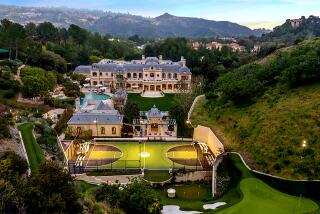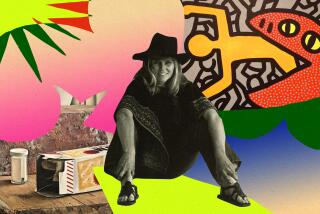Sluggish Market, Sobering Season for Auction Houses : Art: Even after conservative predictions, sales at high-profile spring auctions are falling short of expectations.
- Share via
One more round of high-profile art auctions.
One more round of diminished expectations.
Apart from a $7.26-million sale of Robert Rauschenberg’s “Rebus” and a handful of other relatively high prices, a two-week series of Impressionist, modern and contemporary art sales that came to a close Thursday fell short of predictions.
Lackluster sales were no surprise this spring. A recessionary climate, the disappearance of speculators and a recent rash of art-based scandals in Japan all figured to have a negative effect on the traditional pinnacle of New York’s spring auction season. But Sotheby’s and Christie’s had tailored pre-sale estimates to fit the circumstances, so the results are sobering indeed.
Consider the numbers:
* All four of the season’s prime auctions yielded lower sales totals than expected. Sotheby’s April 30 sale of 74 contemporary works, estimated to reach a total of $23.7 million to $32.2 million, brought a mere $21.26 million. That’s not much more than the $20.68 million paid in 1989 for Willem de Kooning’s “Interchange,” the star painting in a $98-million sale during the height of auction house frenzy.
Christie’s had no better luck last week. Its May 1 auction of 54 contemporary works, valued at a total of $14.86 million to $20.37 million, brought just $11 million.
Results were even more dismal in this week’s sales of Impressionist and modern art. Sotheby’s expected its Tuesday-night auction to bring $31.4 million to $42.7 million, but the auction house rang up only $18.24 million in sales. The evening was saved from disaster by seven pictures from the estate of Irene Mayer Selznick, daughter of film mogul Louis B. Mayer and first wife of producer David O. Selznick. The seven works fetched a total of $7.7 million, safely within the estimated range of $7.3 million to $10.25 million.
Wednesday night at Christie’s, 57 Impressionist and modern artworks were expected to total $34.4 million to $46.6 million, but only $23.1-million worth of art was sold.
* Up to 40% of the items offered in big-ticket evening sales failed to find buyers. Sotheby’s was unable to sell 20 of 74 contemporary pieces on April 30, and Christie’s had to return 15 of 54 contemporary items to sellers on the following night. Works by such revered artists--and formerly hot sellers--as Sam Francis, Philip Guston, Willem de Kooning, Frank Stella and Cy Twombly went begging.
This week, the situation got worse in Impressionist and modern sales. Twenty of 49 works offered by Sotheby’s on Tuesday night attracted no buyers; at Christie’s on Wednesday night, 17 of 57 items were not sold.
* Despite the auction houses’ attempts to set conservative estimates--and thus stimulate bidding--many works were sold below their estimated values. Henri Matisse’s painting “La Robe Persane,” the top item in the Selznick estate, was valued at $5 million to $7 million, but an unidentified European dealer snagged it for $4.5 million.
In contemporary art sales, Sotheby’s sold Rauschenberg’s “Rebus” for $7.26 million--well above its estimated price of $4 million to $6 million--but Christie’s top-selling paintings, Franz Kline’s “West Brand” and Rauschenberg’s “Bait,” brought $1.87 million each. The price fell below the Kline estimate of $2 million to $3 million, but matched the Rauschenberg’s expected price range of $1.8 million to $2.5 million.
The wild bidding that once sent prices soaring to as much as 10 times their estimates was virtually absent this season. Prices that exceeded estimates generally moved up ratherly modestly. Roy Lichtenstein’s 1978 painting “Razzmatazz,” for example, fetched $1.65 million instead of the predicted $800,000 to $1.2 million in Christie’s contemporary art sale.
* The average price for contemporary art fell from $1 million-plus in comparable sales two years ago to about $250,000 this spring; Impressionist and modern art’s average price dropped from nearly $4 million to about $600,000. Forty-four Impressionist and modern works were sold for more than $1 million apiece in a single evening in 1989 at Sotheby’s. In contrast, New York’s four big sales this spring yielded 15 $1-million-plus sales.
Auction-house officials were cautiously optimistic after last week’s contemporary art sales. “The atmosphere in tonight’s sale room was clearly more buoyant than it was six months ago,” Sotheby’s auctioneer John L. Marion said, after selling the $7.26-million Rauschenberg. But the Impressionist and modern art auctions failed to sustain an impression that the market might be turning around.
“We were pleased with the overall results of the Selznick collection, but the rest of the sale was disappointing,” said David Nash, Sotheby’s director of fine arts, after Tuesday’s Impressionist and modern art auction.
“As was the case in last week’s auction of contemporary art, buying was dominated by private collectors from Europe and the United States. The number of lots unsold can be attributed to a lack of dealer participation and a virtual absence of bidding on the part of the Japanese,” Nash said.
Dealers such as Richard Feigen of New York say that the high end of the market will rebound eventually because there is a finite supply of top-quality art and vast amounts of money are in circulation. But it may take several seasons to rebuild confidence. For now, potential sellers of great Impressionist, modern and contemporary artworks are waiting for a more propitious moment to put their treasures on the block and potential buyers seem to be waiting for the market to stabilize.
Meanwhile, many lower-priced areas of the art market are increasingly vigorous. Old Master paintings, Latin American art, photography and jewelry, for example, have picked up new collectors, and their prices have risen quite steadily during the fall of Impressionist, modern and contemporary art.
Smaller auction houses far from New York’s spotlight also have profited by concentrating on less expensive fields. Butterfield & Butterfield, based in San Francisco and Los Angeles, has yet to make a million-dollar sale. (The top price on record there is $732,500, paid in 1984 by the Los Angeles County Museum of Art for Dutch master Hendrick Goltzius’ 1603 painting “Danae Receiving Zeus as a Shower of Gold.”) But while Christie’s total sales fell from $2.14 billion in 1989 to $1.96 billion in 1990, and Sotheby’s sales dropped from $2.95 billion to $2.45 billion in the same period, Butterfield & Butterfield has boosted sales from about $40 million in 1988 to $49 million in 1989 and $55 million in 1990.
More to Read
The biggest entertainment stories
Get our big stories about Hollywood, film, television, music, arts, culture and more right in your inbox as soon as they publish.
You may occasionally receive promotional content from the Los Angeles Times.










